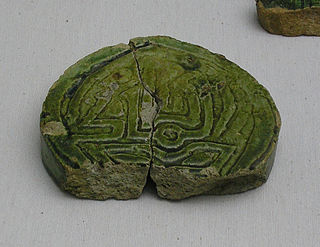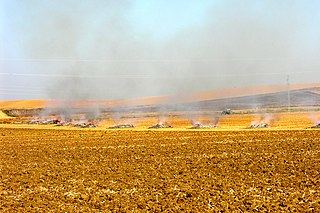 W
WThe Almohad Caliphate [; from Arabic: المُوَحِّدون ] or Banu Abd al-Mumin was a North African Berber Muslim empire founded in the 12th century. At its height, it controlled much of the Iberian Peninsula and North Africa.
 W
WThe Banu Ashqilula were the governors or arraeces of Málaga and Guadix. Their assistance to Muhammad ibn al-Ahmar in founding the Emirate of Granada and their later opposition to al-Ahmar's successors made the Asqilula one of the most influential families of the 13th century Spain. The Ashqilula were one of the clans who were able to maneuver themselves into positions of prominence and influence under the rule of the Nasrid Dynasty. The family first rose to prominence in 1232 when their leader Abu'l Hasan Ali Ibn Ashqilula al-Tujibi helped the Nasrid dynasty during the conquest of Granada. For the first twenty years of Nasrid rule in Granada, the Ashqilula worked closely with al-Ahmar in his early endeavors, like the short lived conquest of Seville. As reward for their service, the Asqilula were granted governorships in the Nasrid territories of Málaga, Guadix and Baza.
 W
WThe Battle of Algeciras was a naval battle which occurred on July 25, 1278. The battle pitted the fleets of the Kingdom of Castile, commanded by the Admiral of Castile, Pedro Martínez de Fe, and the combined fleets of the Marinid dynasty and that of the Emirate of Granada, commanded by Abu Yaqub Yusuf an-Nasr. The battle was fought in the context of the Moorish naval expeditions to the Iberian Peninsula. The battle, which took place in the Strait of Gibraltar, resulted in a Muslim victory.
 W
WThe Battle of Écija was a battle of the Spanish Reconquista that took place in September 1275. The battle pitted the Muslim troops of the Nasrid Emirate of Granada and its Moroccan allies against those of the Kingdom of Castile and resulted in a victory for the Emirate of Granada.
 W
WThe Battle of Iznalloz, was a battle of the Spanish Reconquista fought in the Province of Granada near the city of Iznalloz, north of the city of Granada in 1295. The battle pitted the troops of the Emirate of Granada, commanded by Muhammad II the Sultan of Granada against those of the Kingdom of Castile who were commanded by the Grand Master of the Order of Calatrava, Ruy Pérez Ponce de León on behalf of Sancho IV of Castile. The battle resulted in a catastrophic defeat for Castile and the Order of Calatrava, whose Grand Master died of wounds suffered in the battle.
 W
WThe Battle of Jerez took place in 1231 near the southern Spanish city of Jerez de la Frontera during the Reconquista. King Ferdinand III of Castile and León's troops fought against those of Emir Ibn Hud of the taifa of Murcia. The Castilian forces were led by Ferdinand's brother, Prince Alfonso de Molina, assisted by Álvaro Pérez de Castro; according to some accounts Castro led the Castilians, not Molina. The battle is traditionally seen as marking the collapse of Ibn Hud's authority, and allowing the rise of his successor, Muhammad I.
 W
WThe Battle of Las Navas de Tolosa, known in Arab history as the Battle of Al-Uqab, took place on 16 July 1212 and was an important turning point in the Reconquista and in the medieval history of Spain. The Christian forces of King Alfonso VIII of Castile were joined by the armies of his rivals, Sancho VII of Navarre and Peter II of Aragon, in battle against the Almohad Muslim rulers of the southern half of the Iberian Peninsula. The caliph al-Nasir led the Almohad army, made up of people from all over the Almohad Caliphate.
 W
WThe Battle of Martos was a minor battle of the Spanish Reconquista fought between Martos and Torredonjimeno in Andalusia in 1275. The battle was fought between the troops of the Kingdom of Granada and those of the Kingdom of Castile. The battle resulted in the complete annihilation of the Castilian force. There is some confusion in the dates since different authors report different dates. Zurita, for example, reports that the events described here took place between May and August; the more modern authors, however, put them between September and October.
 W
WThe Battle of Moclín, also known as the Disaster of Moclín, was a battle fought in the Granadian municipality of Moclín on June 23, 1280. The battle pitted the troops of the Emirate of Granada, commanded by Muhammad II, the Sultan of Granada, against those of the Kingdom of Castile and the Kingdom of Leon who were composed mainly of mercenaries and of members of the Order of Santiago, being commanded by the contemporary grand master of the order Gonzalo Ruiz Girón and by Sancho, son of King Alfonso X of Castile.
 W
WThe Battle of Portopí was an open field military conflict between the Almohad troops that occupied the island of Majorca and the Christian army led by King James I the Conqueror with the aim of annexing it to the Crown of Aragon in order to expand their domain. It was carried out at various points in the current Sierra de Na Burguesa, approximately halfway between the current resort town of Santa Ponsa and the City of Majorca. It was the second major battle in the campaign for the conquest of the island of Majorca initiated by the Aragonese king.
 W
WThe Battle of the Puig of 1237, also known as the Battle of the Puig de Santa Maria, the Battle of the Puig de Enesa, or the Battle of the Puig de Cepolla was a battle of the Iberian Reconquista and of the Aragonese Conquest of Valencia.
 W
WThe Conquest of the island of Majorca on behalf of the Christian kingdoms was carried out by King James I of Aragon between 1229 and 1231. The pact to carry out the invasion, concluded between James I and the ecclesiastical and secular leaders, was ratified in Tarragona on August 28, 1229. It was open and promised conditions of parity for all who wished to participate.
 W
WThe Siege of Al-Dāmūs was a battle of the Reconquista that occurred in the year 1210. The forces of the Kingdom of Aragon, together with auxiliary forces of the Knights Templar and Knights Hospitaller, were pitted against the defending forces of the Almohades. The Christian forces defeated the Muslim defenders. This battle was significant because in taking the castle at Ademuz, the Christian forces riled their Muslim opponents to initiate a grand offensive that would eventually culminate in the Battle of Las Navas de Tolosa. This offensive, in turn, marked the end of the Islamic domination of the region and the beginning of Christian rule in the province.
 W
WThe Siege of Algeciras was the first of many sieges of the city by Christian forces in the lengthy period of the Spanish Reconquista. The siege, ordered by King Alfonso X of Castile also known as "el Sabio", was a fruitless military campaign initiated by the Kingdom of Castile with the objective of removing the Benimerins from Algeciras. The siege on Algeciras, then known to the Muslims as Al-Jazira Al-Khadra, was strategically important because Algeciras had been at the time the main fortress and landing place for African reinforcement troops in the Iberian Peninsula. Castile, which had a powerful armada of ships anchored in the Bay of Gibraltar to blockade such reinforcement, had a few days previously to the siege, seen that fleet obliterated by the Muslim admiral, Abu Yusuf Yaqub at the Naval Battle of Algeciras.
 W
WThe Siege of Burriana was one of the battles that occurred during the Conquest of Valencia by James I of Aragon. Burriana was an important Muslim city, being the capital of La Plana, Valencia. It was known as the "Green City". The city was besieged for two months, finally falling to the forces of James I in July 1233.
 W
WThe Siege of Jaén was one of many sieges on the city during the long Spanish Reconquista. The siege, which was carried out by the combined allied forces of the Kingdom of Castile and the Taifa of Baeza, commanded by Ferdinand III of Castile and Abd Allah Ibn Muhammad Al-Bayyasi of Baeza against the defending Taifa of Jayyān (جيان) whose forces were commanded by the notable Christian knight, Álvaro Pérez de Castro. The battle resulted in a Jayyānese victory as the Castilian forces did not capture the city. Areas around the city were totally devastated as a result of the siege. The siege occurred as a part of Ferdinand III's first campaign which occurred roughly from 1224 to 1230 and was undertaken before the Siege of Andújar that same year.
 W
WThe Siege of Jaén was one of many sieges on that city during the Spanish Reconquista. The siege was carried out from 24 June through September, 1230 by forces of the Kingdom of Castile commanded by Ferdinand III of Castile against the defending Taifa of Jayyān (جيان). The battle resulted in a Jayyānese victory after the Castilian withdrawal and abandonment of the siege immediately following the death of King Alfonso IX of León.
 W
WThe Siege of Jaén was the final siege on the city during the Spanish Reconquista. The siege, was carried out from 1245 through 28 February 1246 by forces of the Kingdom of Castile and the Order of Santiago commanded by Ferdinand III of Castile and the Grand Master of the Order of Santiago, Pelayo Pérez Correa, against a combined defending force of the local Taifa of Jaén (جيان) and the Emirate of Granada under Muhammad I. The battle resulted in a Castilian victory with the city of Jaén being handed over to the Kingdom of Castile and Leon after the signing of the Treaty of Jaén.
 W
WThe Siege of Seville was a 16-month successful investment during the Reconquista of Seville by forces of Ferdinand III of Castile. Although perhaps eclipsed in geopolitical importance by the rapid capture of Córdoba in 1236, which sent a shockwave through the Muslim world, the Siege of Seville was nonetheless the most complex military operation undertaken by Fernando III. It is also the last major operation of the Early Reconquista. The operation also marked the appearance of indigenous naval forces of Castile-León of military significance. In effect, Ramón de Bonifaz was the first admiral of Castile, although he never held an official title of that kind.
 W
WThe taifas were the independent Muslim principalities of the Iberian Peninsula, referred to by Muslims as al-Andalus, that emerged from the decline and fall of the Umayyad Caliphate of Córdoba between 1009 and 1031. They were a recurring feature of al-Andalus history. Conquered by the Almoravids in the late 11th century, on its collapse many taifas re-appeared only to be subsumed by the Almohads. The fall of the latter resulted in a final flourishing of the taifas, but by the end of the 13th century only one remained, Granada, the rest being incorporated into the Christian states of the north.